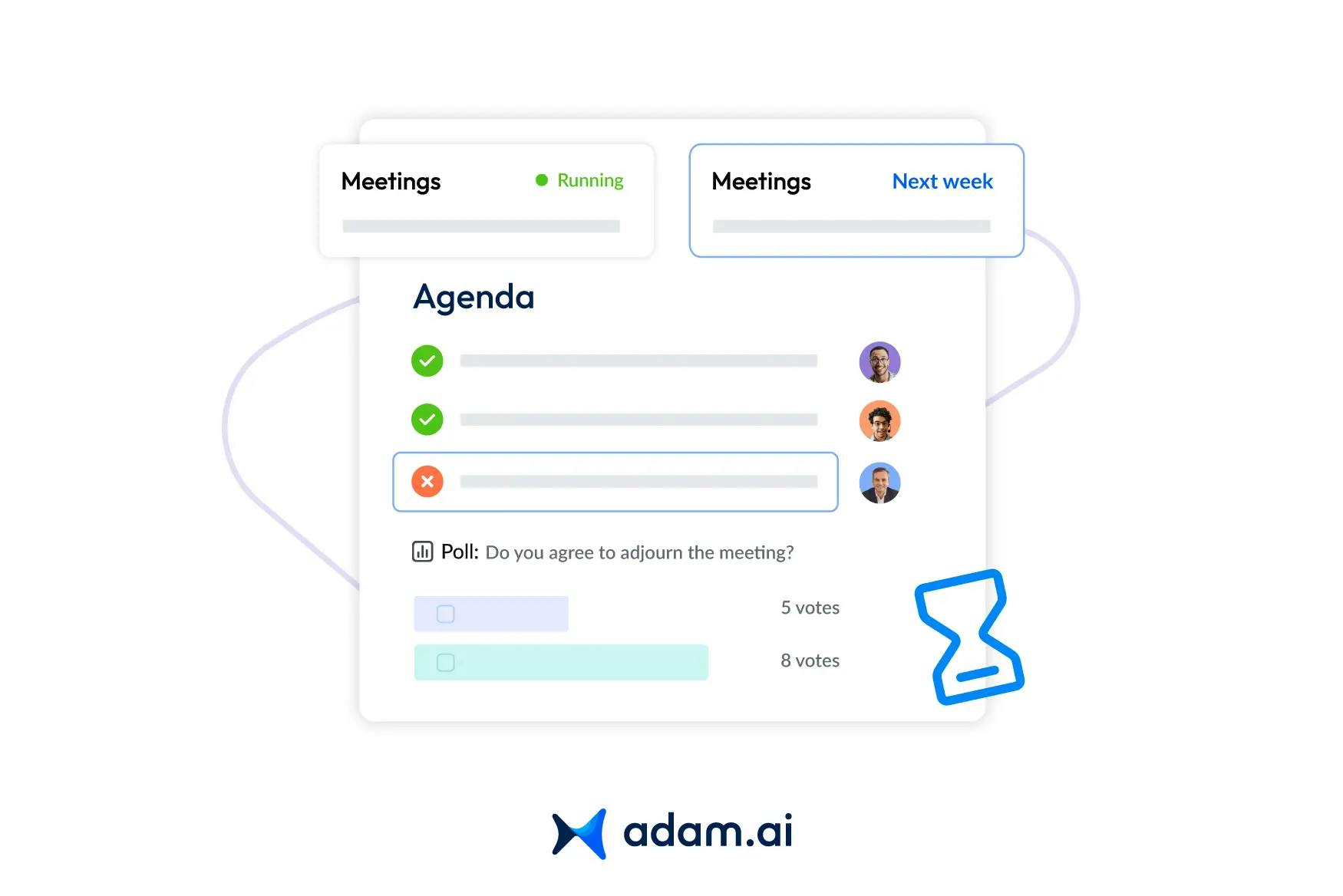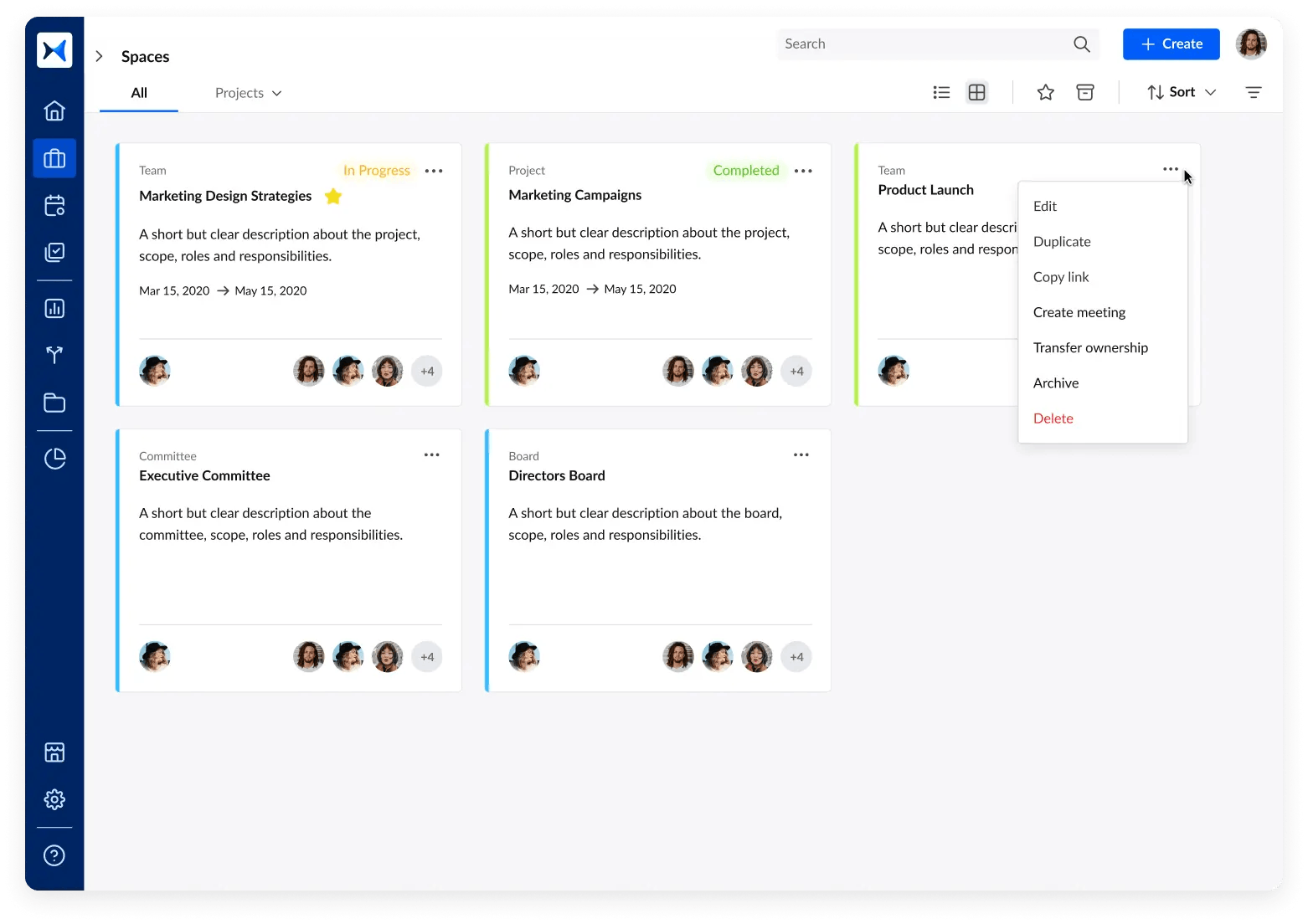June 3, 2024 · 8 min read
Adjourning Meeting: Best Practices for Board Efficiency

Shaimaa Badawi

Adjourning a meeting is a critical component of effective board management. It ensures that all discussions are properly concluded, and necessary actions are clearly outlined for future follow-up. Understanding the process and best practices for adjourning a meeting can significantly enhance the efficiency and productivity of your board meetings. This article covers everything you need to know about adjourning meetings, from the types of adjournment to practical steps, examples, and best practices.
What is a meeting adjournment?
A meeting adjournment is the formal process of concluding a meeting. This typically occurs when all items on the agenda have been discussed or when the scheduled meeting time has ended. If there are any unfinished items, they are usually carried over to the next meeting. The chairperson ensures that no critical matters are left unaddressed before adjourning.
How do I adjourn a board meeting?
Adjourning a board meeting involves a series of steps to ensure all business is concluded efficiently and appropriately. Here’s how to do it:
1. Discuss final agenda items: Ensure all scheduled topics on the agenda have been thoroughly covered and resolved.
2. Invite additional business: The chairperson should ask if there is any further business or issues that need to be addressed. If any new topics arise, decide whether to discuss them immediately or defer them to the next meeting.
3. Provide final comments: Summarize the decisions made, resolutions passed, and any actions that need to be taken before the next meeting. This helps ensure clarity and understanding among board members.
4. Announce adjournment: The chairperson formally announces the intention to adjourn the meeting.
5. Officially close the meeting: Officially state that the meeting is adjourned, concluding the session.`
What do you say to end a board meeting?
When it’s time to end a board meeting, the chairperson must officially declare the meeting adjourned. Here are some common phrases and steps to do so:
- Request a motion to adjourn:
- "Can I have a motion to adjourn the meeting?" "Is there a motion to adjourn?"
- Making and seconding the motion:
- A board member responds: "I move to adjourn the meeting." Another member seconds: "I second the motion."
- Conducting a vote:
- "All in favor, say yes." "All opposed, say no."
- Declaring the meeting adjourned:
- "Hearing no objection, I declare the meeting adjourned." "The meeting is adjourned at [TIME]." "There being no further business, the meeting is adjourned."
Are there different types of adjournment?
Yes, there are three primary types of adjournment in the business context:
1. Immediate adjournment
This is the process of ending the meeting right away. A board member can simply state, "I move to adjourn." If the motion is adopted, the meeting concludes immediately, even if there is unfinished business.
2. Adjournment to continue later
This type involves suspending the meeting until a specified future time. It is not a privileged motion, meaning it must wait until all other business is complete. The remaining agenda items are then addressed at the next scheduled session.
3. Adjournment sine die
This means adjourning the meeting without setting a date for the next meeting. It is often used for the final session of a body or when it is uncertain when the next meeting will occur. This also is not a privileged motion and must wait until other business is complete.
What is a privileged motion in adjourning meeting?
A privileged motion is a special type of motion that takes priority over standard business because of its urgency or significance. Here’s how it works:
- Superseding ordinary business: Privileged motions can be made while other discussions are in progress, interrupting the current business due to their priority.
- Common examples: These include motions to fix the time to adjourn, motions to adjourn, motions to take a recess, and raising questions of privilege.
- Non-debatable: Privileged motions are not open for debate. This means the board chair must call for an immediate vote on the motion.
What does Robert's Rules say about adjournment?
Under Robert's Rules of Order, the guidelines for adjourning a meeting are straightforward and structured to maintain order and efficiency. Here are the key points:
- No interruption: A board member cannot interrupt a speaker who has the floor to move for adjournment.
- Seconding the motion: A motion to adjourn must be seconded by another board member.
- Non-debatable: Typically, a motion to adjourn is not open for debate or amendment.
- Majority vote required: To pass, a motion to adjourn must receive a majority vote from the board members present.
Exceptions:
- Debatable motion: If the motion to adjourn specifies a time for adjournment or a specific future time to reconvene, it can be debated or amended.
- Failed motion: If the motion to adjourn does not pass, the meeting continues with its regular business. The motion cannot be reconsidered but can be proposed again later in the meeting.
When should a meeting be adjourned?
A meeting should be adjourned under the following circumstances:
Completion of agenda items
The meeting concludes when all scheduled items on the agenda have been discussed and resolved. This includes reviewing reports, considering motions, and addressing any additional business brought up by board members.
End of the scheduled time
Meetings should respect the allotted time to honor board members' schedules. Adhering to the set duration prevents meetings from dragging on, ensuring that participants remain engaged and focused.
Lack of quorum
If the required number of members (quorum) is not present, the meeting must be adjourned and rescheduled. This is often mandated by laws or the organization's bylaws to ensure valid decision-making.
Best practices for efficient meeting adjournment
Planning ahead
- Structured agenda: Create a detailed agenda with specific times for each topic to ensure the meeting stays on track.
- Pre-meeting preparation: Distribute meeting materials in advance, allowing board members to review and prepare, thus minimizing time spent answering basic questions during the meeting.
Strong leadership
- Effective chairing: The chairperson should guide the meeting efficiently, ensuring all topics are covered within the allocated time while allowing everyone a chance to speak.
- Managing discussions: If a topic requires more time than anticipated, the chair can pause the discussion and schedule it for the next meeting to keep the current meeting on schedule.
Clear communication
- Summarizing outcomes: Before adjourning, summarize the decisions made and outline any actions required, including responsibilities and deadlines.
- Confirming action items: Ensure all participants are clear on their tasks and the timeline for completion.
Resolving conflicts and ending positively
- Addressing disagreements: Aim to resolve any conflicts during the meeting and emphasize common goals to maintain a united board.
- Closing positively: End the meeting on a positive note to foster a cooperative and motivated atmosphere.
Solicit feedback
- Asking for input: Before adjourning, invite board members to provide feedback on the meeting process and suggest topics for the next meeting. This can help improve future meetings.
Finalizing details for the next meeting
- Planning continuity: Note any unfinished business and ensure it is included in the next meeting’s agenda. Confirm the next meeting’s date and time if necessary.
Seamlessly manage and adjourn board meetings with adam.ai
Efficiently managing board meetings, including the process of adjourning them, requires a robust meeting management platform. Board members need tools that not only streamline meeting logistics but also enhance the overall meeting experience. Introducing adam.ai, the intuitive meeting management platform for boards, committees, and projects designed to facilitate all meeting aspects, from scheduling to adjournment.
Here's how adam.ai can help with meeting adjournment and overall efficiency:
- Unlimited booking pages: Easily organize and schedule meetings between board members, committees, and stakeholders. This feature simplifies the scheduling process, ensuring timely and regular board interactions, essential for efficient meeting adjournments.

- Smart note-taking system: Record agenda items, actions, decisions, and notes with a user-friendly interface. Integrated with built-in video conferencing, this system allows board members to discuss and make decisions seamlessly, reducing delays and helping to conclude meetings on time.

- Action and decision tracking: Keep track of actions and decisions made during board meetings to ensure follow-through. This feature helps board members stay updated on progress and outcomes, enhancing accountability and making it easier to adjourn meetings with clear follow-up plans.

- Categorize meetings into spaces: Organize meetings into specific spaces for various boards, committees, teams, and projects. This categorization helps maintain clear records and focus on specific areas of governance, facilitating smoother adjournment processes by keeping meetings structured.

- Generate and share meeting minutes: Automatically generate and share meeting minutes to ensure transparency and maintain a comprehensive record for future reference. This feature ensures that all discussions and decisions are documented, making it easier to review and adjourn meetings effectively.

- Analytics dashboard: Assess participation rates, decision outcomes, and the progress of action items. This feature provides insights that facilitate smooth and effective meetings, helping board members stay informed and proactive, which is crucial for timely adjournments.

Transform how you conduct critical meetings—From meticulous preparation to effective execution and insightful follow-up, adam.ai integrates comprehensive analytics, full customization, and intuitive interfaces with powerful meeting management tools.
Easy onboarding. Enterprise-grade security. 24/7 dedicated support.
The bottom line
Efficiently adjourning a meeting is essential for maintaining order and productivity within board meetings. By adhering to structured processes and employing best practices, you can ensure that all agenda items are addressed, critical actions are tracked, and the meeting concludes on a positive note. Board members should leverage advanced meeting solutions to facilitate this process and enhance overall meeting management.
And while there may be multiple solutions available, here is why adam.ai is the meeting management software platform you can trust:
- adam.ai is one of Atlassian Ventures' portfolio companies.
- In the meeting management software category on G2, adam.ai has been ranked a leader and a high performer for successive quarters in the past years.
- adam.ai has been included in the Forrester Report in the AI-enabled meeting technology landscape.
- adam.ai is trusted and used by powerful teams and organizations worldwide for all types of critical meetings, like board, committee, project management, and business development meetings.
- And most importantly, adam.ai integrates with your existing workflow, is SOC2 compliant, provides dedicated support and success, and has a free trial option.
Subscribe to adam.ai blog
Stay ahead with the latest insights—get our newest blog posts, tips, and updates sent straight to your inbox.